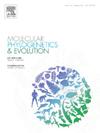探讨被子植物353标记在东地中海兰科植物物种鉴定中的潜力
IF 3.6
1区 生物学
Q2 BIOCHEMISTRY & MOLECULAR BIOLOGY
引用次数: 0
摘要
块茎兰花是生态脆弱的物种,受到过度采伐、放牧和土地利用变化等一系列环境压力的威胁。保护工作需要准确的物种鉴定,但传统遗传标记有限的系统发育分辨率阻碍了这一工作,而关于兰科植物分类的广泛分类冲突加剧了这一问题。目标富集有望通过提供大量的核位点来提高系统发育分辨率和评估竞争物种模型,从而解决这两个挑战。在这里,我们评估了Angiosperms353标记区分50多种原产于希腊的块茎兰花的有效性,并探索了将这些标记缩小到一个更小的集合的可能性,这个集合可以作为一个最小的探测集。我们的方法包括三个层次的方法:1)利用所有具有足够目标恢复的被子植物353基因座生成物种水平的系统发育,2)通过贝叶斯因子物种划分评估基于“分裂者”和“lumper”分类的竞争物种模型,以及3)根据它们的系统发育信息对被子植物353基因座区分不同分化时间谱系代表的潜力进行排序。虽然推断的多物种聚结系统发育总体上有很高的支持,但贝叶斯因子划分显示出混合结果,在Serapias中倾向于分裂,而在Ophrys中倾向于基础分支的分裂和最近分化的分支的集中。一项对Ophrys的分子钟分析证实,在进化不确定的进化枝中存在快速和近期的辐射,这表明需要额外的基因座来完全确定这一属。最后,我们发现30个基因座在兰科的四个进化时期具有高度的系统发育信息;我们认为这些是未来标志物开发的有希望的候选物。我们的研究结果增强了植物生命之树(PAFTOL),为以前在用这些标记构建的树中代表性不足的物种提供了额外的系统基因组数据,同时揭示了正在进行的“分裂者”与“块状”争论,并为块状兰花的物种鉴定提供了新的方向,块状兰花是一个具有独特分类和保护挑战的群体。本文章由计算机程序翻译,如有差异,请以英文原文为准。

Exploring the potential of Angiosperms353 markers for species identification of Eastern Mediterranean orchids
Tuberous orchids are ecologically vulnerable species, threatened by a range of environmental pressures such as overharvesting, grazing and land use change. Conservation efforts require accurate species identification, but are impeded by limited phylogenetic resolution of traditional genetic markers, which is exacerbated by widespread taxonomic conflict regarding the classification of orchids. Target enrichment holds promise to resolve both these challenges by offering a large set of nuclear loci with which to increase phylogenetic resolution and evaluate competing species models.
Here, we evaluate the effectiveness of the Angiosperms353 markers for distinguishing over 50 tuberous orchid species native to Greece and we explore the possibility of narrowing these markers to a smaller set that could function as a minimal probe set. Our methodology consists of a three-tiered approach: 1) generating a species-level phylogeny using all Angiosperms353 loci with sufficient target recovery, 2) evaluating competing species models based on “splitter” and “lumper” classifications through Bayes Factor species delimitation, and 3) ranking the potential of Angiosperms353 loci to discriminate representatives of lineages with different divergence times based on their phylogenetic informativeness. While the inferred multi-species coalescent phylogeny had overall high support, Bayes Factor delimitation revealed mixed outcomes, favouring splitting in Serapias, while favouring splitting in basal clades and lumping in more recently diverged clades in Ophrys. A molecular clock analysis of Ophrys confirms rapid and recent radiation in clades marked by phylogenetic uncertainty, suggesting the need for additional loci to fully resolve this genus. Finally, we found 30 loci to be highly phylogenetically informative across four epochs of Orchidinae evolution; we suggest these are promising candidates for future marker development. Our findings enhance the Plant Tree of Life (PAFTOL) by contributing additional phylogenomic data for species that were previously underrepresented in trees built with these markers, while shedding light on the ongoing “splitter”-vs-“lumper” debate and offering new directions for species identification of tuberous orchids, a group with distinct taxonomic and conservation challenges.
求助全文
通过发布文献求助,成功后即可免费获取论文全文。
去求助
来源期刊
CiteScore
7.50
自引率
7.30%
发文量
249
审稿时长
7.5 months
期刊介绍:
Molecular Phylogenetics and Evolution is dedicated to bringing Darwin''s dream within grasp - to "have fairly true genealogical trees of each great kingdom of Nature." The journal provides a forum for molecular studies that advance our understanding of phylogeny and evolution, further the development of phylogenetically more accurate taxonomic classifications, and ultimately bring a unified classification for all the ramifying lines of life. Phylogeographic studies will be considered for publication if they offer EXCEPTIONAL theoretical or empirical advances.

 求助内容:
求助内容: 应助结果提醒方式:
应助结果提醒方式:


